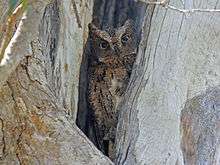Rainforest scops owl
| Rainforest scops owl | |
|---|---|
 | |
| Kirindy Forest, Madagascar | |
%2C_Andasibe%2C_Madagascar.jpg) | |
| Juvenile at Andasibe, Madagascar | |
| Scientific classification | |
| Kingdom: | Animalia |
| Phylum: | Chordata |
| Class: | Aves |
| Order: | Strigiformes |
| Family: | Strigidae |
| Genus: | Otus |
| Species: | O. rutilus |
| Binomial name | |
| Otus rutilus (Pucheran, 1849) | |
The rainforest scops owl (Otus rutilus), also known as the Malagasy scops owl or Madagascar scops owl, is a species of owl in the family Strigidae. It is found in a large part of eastern Madagascar, but the exact distribution limits between it and the Torotoroka scops owl (O. madagascariensis), with which it was long considered conspecific, require further study.
Description
The rainforest scops owl is a relatively small owl with short, rounded wings and short erectile ear tufts on top of the head. There are three morphs recorded from this species a grey plumaged morph, a brown plumaged morph and a rufous plumaged morph. Features which stand out from the main plumage color are the pale eyebrows, light spots on the scapulars and the barring on the wings and outer tail feathers. Sometimes the crown and the underparts are streaked. The bill has a black tip and may be dull green through to yellowish grey and the eyes are yellow. They measure 22–24 cm (8.7–9.4 in) in length and have a wingspan of 52–54 cm (20–21 in).[2]
Voice
The typical song of the rainforest scops owl is a series of between five and none short, reverberating, clear hoots which can be rendered as "pu-pu-pu-pu-pu", these are repeated at intervals of several seconds.[3]
Distribution and habitat
The rainforest scops owl is endemic to Madagascar where it is found in the east of the island. As its common name suggests it prefers humid tropical forest and bush.[4]
Habits
The rainforest scops owl feeds on invertebrates, such as grasshoppers, beetles, moths and spiders; as well as taking small vertebrates. It hunts mostly at night from a perch but will also catch moths on the wing.[2][3] It roosts during the day, hidden in dense foliage, on a branch or next to the tree trunk. Little is known about the breeding biology of this species, the nest is in a hole in a tree trunk and 3-4 white eggs are laid, probably in November - December.[3]
Taxonomy
The rainforest scops owl, the Mayotte scops owl Otus mayottensis, the Pemba scops owl Otus pembaensis and the torotoroka scops owl Otus madagascarensis have all previously been lumped as one species. The taxonomy is in state of flux but recent genetic studies have placed the Pemba scops owl closer to the clade containing the African scops owl Otus sengalensis, while the Mayotte scops owl is clearly separate from the remaining two. The status of the rainforest and torotoroka scops owls as separate species is debatable as there may be very little genetic distance between the two taxa.[5][6]
References
- ↑ BirdLife International (2012). "Otus rutilus". IUCN Red List of Threatened Species. Version 2012.1. International Union for Conservation of Nature. Retrieved 16 July 2012.
- 1 2 "Malagasy or Rainforest Scops Owls". beautyofbirds.com. Retrieved 27 October 2016.
- 1 2 3 "Madagascar Scops Owl ~ Otus rutilus". The Owl Pages. Deane Lewis. Retrieved 27 October 2016.
- ↑ "Rainforest Scops-Owl Otus rutilus (Pucheran, 1849)". Avibase. Denis Lepage. Retrieved 27 October 2016.
- ↑ Fuchs, Jérôme; et al. (2008). "Tracing the colonization history of the Indian Ocean scops-owls (Strigiformes: Otus) with further insight into the spatio-temporal origin of the Malagasy avifauna". BMC Evolutionary Biology.
- ↑ Fuchs, Jérôme; Pons, Jean-Marc; Pasquet, Eric; Raherilalao, Marie Jeanne; Goodman, Steven M. (2007). "Geographical Structure of Genetic Variation in the Malagasy scops-owl inferred from Mitochondrial Sequence Data (abstract)". Condor. 109 (2): 408–418.
